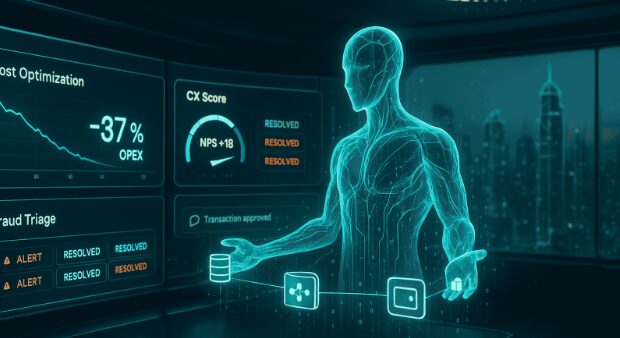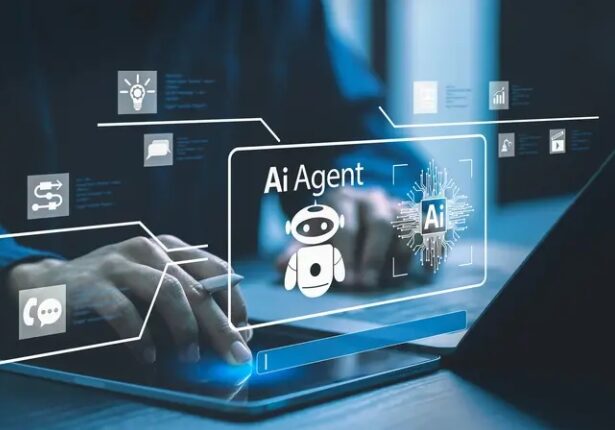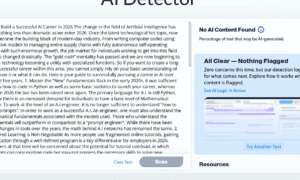For years, the promise of AI in fintech felt stuck in first gear, limited to scripted chatbots that frustrated customers more than they helped. But a fundamental shift is underway. The technology has evolved from merely responding to queries to autonomously executing complex tasks, presenting a watershed moment for financial institutions to radically reduce operational expenditure (OPEX) and deliver a new caliber of customer experience (CX).
This isn’t another incremental upgrade; it’s a new operational paradigm. While first-generation bots deflected simple questions, today’s AI agents act as diligent, 24/7 digital employees. They don’t just answer what a customer’s balance is; they analyze cash flow, execute transactions, and resolve disputes across multiple systems—all without human intervention.
The Costly Limits of First-Gen Chatbots
The initial wave of chatbots was built on a simple premise: deflect volume from expensive human agents. While they succeeded in handling basic, repetitive questions, their limitations quickly became a financial and reputational drag. Industry data reveals that average chatbot containment rates—the percentage of queries resolved without human hand-off—hover around 65-70% for simple issues, but plummet for complex financial inquiries.
Each failure represents a cost. When a bot fails, the query escalates to a live agent, incurring not just the agent’s salary but also the cost of the initial failed interaction and the customer’s frustration. A leading European neobank, for example, found that even after optimizing its support flows, each live agent chat still costs the company an average of $3. For an institution handling tens of thousands of support tickets daily, these costs spiral into millions annually.
This model creates a disjointed customer journey. Users are forced to repeat themselves, navigating from a rigid bot to a human agent, eroding trust and satisfaction. The core problem is that these bots lack agency; they are passive responders, not active problem-solvers.
What Exactly Is an Autonomous AI Agent?
An autonomous AI agent is a software program designed to perceive its digital environment, make decisions to achieve a specific goal, and take action to execute those decisions. Think of it less like a conversational script and more like a cognitive-digital worker. It operates on a continuous loop, constantly assessing situations and executing multi-step tasks to reach a desired outcome.
Building Blocks in Plain English
At its core, an agent’s architecture rests on three pillars:
- Perception: The agent ingests data from its environment. This could be a customer’s query, a fraud alert from a transaction monitoring system, or data from a KYC document. It uses technologies like natural language processing (NLP) and computer vision to understand this unstructured information.
- Decision (or Reasoning): This is the agent’s “brain.” Using a large language model (LLM) or a similar reasoning engine, the agent analyzes the perceived data, considers its objective, and determines the optimal sequence of actions. For instance, if the goal is to resolve a chargeback dispute, it might decide to first pull transaction records from one system, then check shipping information in another, and finally draft a response.
- Action (or Tool Use): Once a decision is made, the agent uses a set of tools—APIs, robotic process automation (RPA) modules, or database connectors—to execute the plan in the real world. This could involve updating a CRM, placing a transaction, or sending a customer a personalized email.
How Agents Differ from RPA, Chatbots, and Decision Engines
It’s crucial to distinguish agents from their technological predecessors. A chatbot can talk, but it cannot act outside its conversational script. RPA can act, but it cannot reason; it blindly follows a predefined workflow and breaks when conditions change. A decision engine can recommend an action (e.g., “approve loan”), but it cannot execute the multi-step process of disbursing the funds.
An autonomous agent unifies these capabilities. It reasons like a human analyst, acts like an RPA bot, and can communicate like a chatbot, creating a cohesive, end-to-end automation solution that is both resilient and intelligent.
Five High-Impact Use Cases for 2025
The true power of AI agents is their versatility. They can be deployed across front, middle, and back-office functions to drive efficiency and improve accuracy.
- KYC/AML Onboarding: Manual document verification is a notorious bottleneck, with reviews taking anywhere from hours to days, resulting in increased customer drop-off. An AI agent can instantly scan and validate IDs, cross-reference databases for sanctions screening, and flag anomalies for human review, reducing onboarding time by over 90%.
- Chargeback Dispute Automation: The chargeback process is a manual, evidence-gathering nightmare. An agent can autonomously pull transaction data, merchant communications, and delivery confirmations from disparate systems, assemble a complete evidence package, and submit it through the payment network’s portal, freeing up entire teams of analysts.
- Fraud-Alert Triage: Security teams are inundated with false positives from fraud detection systems. An agent can perform the initial investigation for each alert, enriching the case file by pulling customer history and transaction context. It can then either resolve the low-risk alert or escalate a well-documented case to a human investigator, allowing teams to focus on genuine threats.
- Treasury Cash-Flow Forecasting: Corporate treasury departments often rely on complex spreadsheets for cash management. An AI agent can connect to bank accounts, accounting software, and market data feeds to generate real-time cash flow forecasts, model different scenarios, and even execute predefined rebalancing strategies.
- Hyper-Personalized Customer Care (Voice + Text): Modern agents can operate over both voice and text channels. They can handle complex queries like “My card was declined at a store in Paris, can you tell me why and help me make the payment?” The agent can check fraud alerts, explain the block, offer to temporarily whitelist the merchant, and re-run the transaction—a resolution that previously required a skilled human agent.
“By mid-2025, AI agents will handle 40% of routine banking ops, predicts Juniper Research.”
Architecture Deep-Dive at a Glance
The technical magic behind an AI agent is a “perception-decision-action” loop, often orchestrated by a framework like LangChain or a custom implementation. The agent’s core logic receives data, passes it to a reasoning model (like an LLM), which is given access to a specific set of “tools” (APIs). The model then selects the right tool to call with the right parameters to move closer to its goal.
Pilot Playbook: From Idea to Production in 6 Sprints
Deploying an AI agent doesn’t require a multi-year transformation project. An agile, sprint-based approach allows fintechs to deliver value quickly while managing risk.
- Process Mapping: Identify a high-volume, rule-heavy, and costly manual process. Deconstruct every step and decision point to create a blueprint for the agent.
- Data Custodianship & Security Checks: Define exactly what data the agent can access. Ensure all data handling complies with GDPR, CCPA, and other regulations, and that API access is secure and narrowly scoped.
- Rapid Prototype (LLM + Tool Wrapper): In a sandboxed environment, connect a powerful LLM to a few core APIs (tools). The goal is to prove the agent can perform the core tasks, not to perfect it.
- Human-in-the-Loop QA: Deploy the agent internally with a human supervisor. The agent suggests actions, and the human approves or corrects them. This generates valuable training data and builds trust.
- Risk & Compliance Sign-Off: Formally document the agent’s behavior, decision-making criteria, and audit trails. Present this to risk and compliance teams for formal approval before any customer-facing interaction.
- Controlled Rollout and KPI Tracking: Release the agent to handle a small percentage of live cases (e.g., 5%). Closely monitor key performance indicators (KPIs) like resolution time, accuracy, and cost per interaction before scaling up.
Risk, Governance & Regulatory Guardrails
Autonomy requires accountability. For fintechs, deploying agents mandates a robust governance framework. This includes continuous monitoring for “model drift,” where an agent’s performance degrades over time, and conducting regular bias audits to ensure it doesn’t discriminate against certain customer segments.
Every action and decision made by the agent must be logged in an immutable audit trail, making its behavior fully transparent to regulators. Aligning the agent’s operational environment with standards like SOC 2 and PCI DSS is not optional; it’s a prerequisite for earning and maintaining trust with both customers and regulators.
ROI Snapshot: Crunching the Numbers
The business case for AI agents is compelling. By automating end-to-end workflows, they deliver measurable improvements across efficiency, cost, and customer satisfaction.
| Metric | Before Agent (Manual Process) | After Agent (Automated Process) | Delta |
| Cost Per Ticket | $8.50 | $5.35 | -37% |
| Avg. Resolution Time | 48 hours | 15 minutes | -99% |
| FTE Hours / 1,000 Tickets | 120 hours | 8 hours (human review) | -93% |
| Net Promoter Score (NPS) | +25 | +43 | +18 |
Next Steps for Fintech Leaders
The transition from chatbots to agents is no longer a futuristic vision; it is a present-day strategic imperative. The first step is to shift the organizational mindset from “call deflection” to “process automation.” Leaders should task their teams with identifying the top three most painful, high-volume workflows and begin the pilot playbook. Building these capabilities in-house with the right talent can transform a forward-thinking fintech company into a market leader.
For those looking to accelerate this journey, partnering with specialists can provide the necessary expertise to build and deploy production-grade autonomous AI agents that tackle real operational work safely and efficiently. The technology is ready. The question is whether your organization is ready to harness it.
FAQs
- How is an AI agent different from our existing RPA bots?
RPA bots follow rigid, pre-programmed scripts and break when the UI or process changes. AI agents are dynamic; they use reasoning to adapt to new situations, handle exceptions, and execute tasks across multiple systems without a brittle script. - What is the typical timeline for deploying a first agent?
Following an agile, 6-sprint playbook, a fintech can move from an idea to a production pilot handling live traffic in approximately 12 to 16 weeks. - Does an agent replace human jobs?
No, it redefines them. Agents handle the high-volume, repetitive work, freeing up human experts to focus on complex edge cases, strategic analysis, and building better customer relationships. It’s a shift from manual processor to expert overseer. - How do you ensure regulatory compliance (e.g., with GDPR)?
Compliance is designed in from day one. Agents are built with strict data access controls (they only see what they need), their decisions are fully auditable, and their data handling protocols are aligned with standards like GDPR and SOC 2. - What’s the biggest mistake companies make when adopting this technology?
The most common mistake is treating it like a traditional IT project with a long, waterfall development cycle. The key is an agile, iterative approach: start small with a high-impact use case, prove the value quickly, and scale from there.
Conclusion: Banking Autonomy Without Breaking the Bank
The financial services industry is at a critical inflection point. The operational models of the past, reliant on armies of manual processors and fragile automation, are no longer sustainable. They are too slow, too expensive, and deliver a customer experience that falls short of modern expectations.
Autonomous AI agents offer a direct path to a more efficient, resilient, and customer-centric future. By empowering digital systems with the ability to reason and act, fintechs can finally solve the long-standing tension between cost reduction and service excellence. The era of banking autonomy has arrived, and it’s more accessible than you think.




































